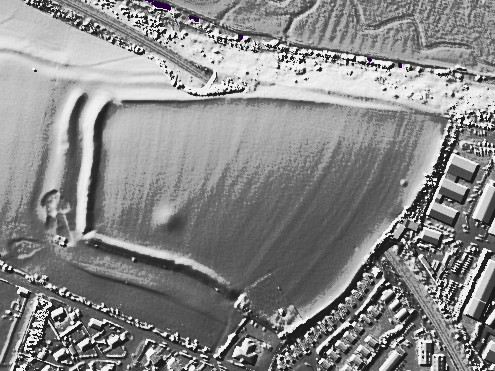
Open Source Environment agency LIDAR

Open Source Environment agency LIDAR

9/3/12

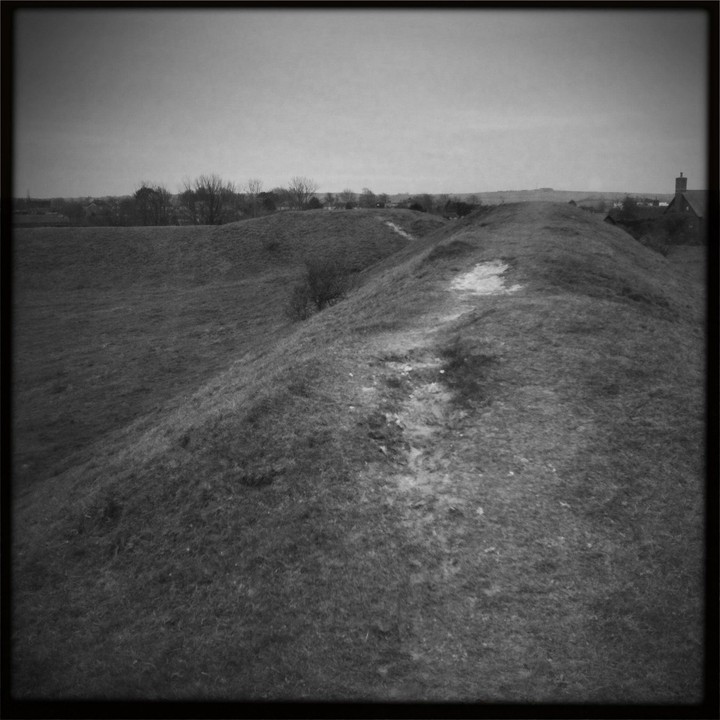

9/3/12


The northwest corner of the hillfort from Whitfield farm long barrow, the railway tunnel which saved Poundbury from being destoyed can clearly be seen. The wall in the foreground is an old firing range.

An aerial photo of Poundbury from the 1930’s, north is to the right of the picture.

This is a 1759 engraving by J.Newton and it hangs on my bedroom wall. The view itself would be impossible now as everthing is hugely built up.

The southern and western inner banks from the top of the barrow looking west.

The full length view of the western inner bank from the northern bank.

Looking east along the length of the north rampart.

The ditch between the two western ramparts.

The bowl barrow in the interior of the fort.

Poundbury from the north, showing the interior of the hillfort and the roman aqueduct, which runs along the hillside.

The west side of the hillfort, the low bank in the fore ground is the area of the original neolithic enclosure.

This broken flint blade was found within the ramparts of Poundbury in the spoil of a mole hill. The white arrow shows the stiking platform and bulb of percussion, characteristic of knapped flint tools.

Poundbury with the Frome (circa 1949 ish)

The western ditch and banks.

The north rampart from inside.
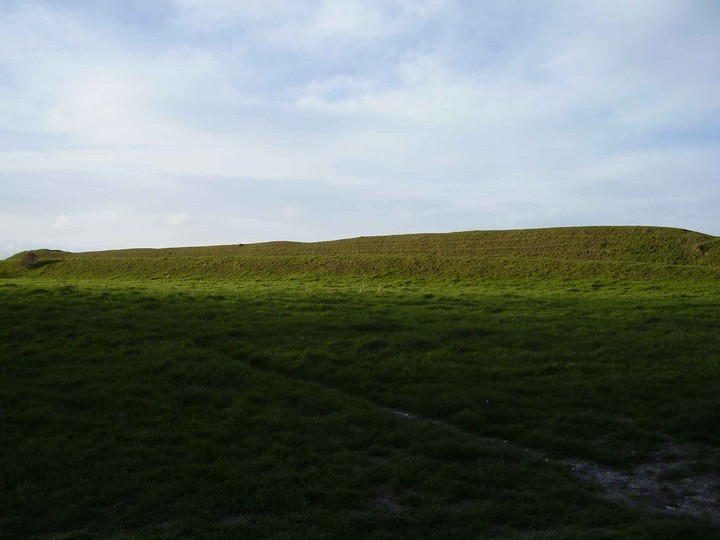
The south rampart from outside (about half its length.)

The round barrow inside the hillfort, looking west.
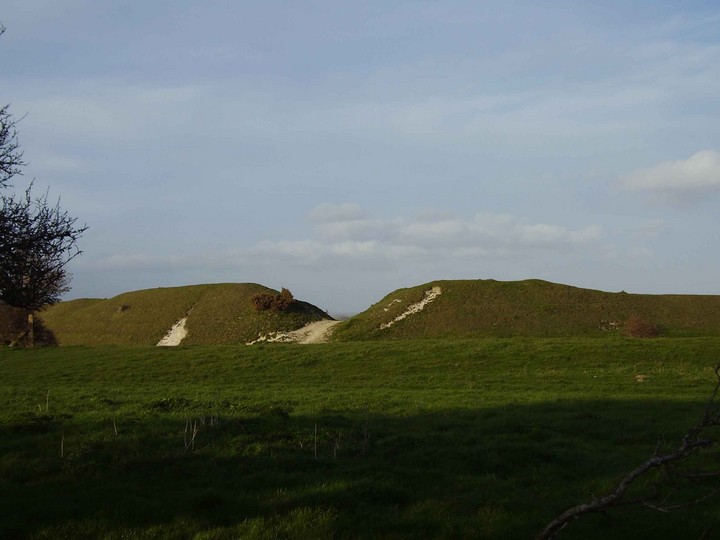
The south west corner, not an original entrance.
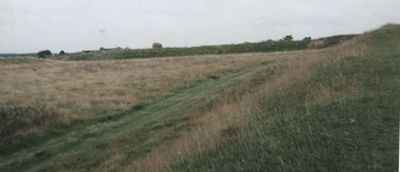
On visiting yesterday I found the ever growing housing estate of Pounbury growing closer, in fact in places the view is dominated by the faux historic architecture.
Even so Poundbury Hillfort still retains its soul, housing estates, construction works, railway lines all play a part in its modern day perspectives but do not disconnect this place from Maiden Castle or the landscape as a whole. Although very easily accessible from the road this still feels like a hidden place, perhaps because it’s somewhat on the edge of time. Well worth a visit if you find yourself near to Dorchester.
Probably the most accessible Dorset hillfort , you don’t have to climb a great height or park miles away from it. It’s a quite simple, roughly square shape with double ditches and banks on its southern and western sides . Inside the enclosure there is a single bronze age round barrow and hut circle marks which have been excavated . To the east of it on lower ground a grave yard of at least a thousand burials ranging from pre-Roman to c.400 c.e. has been extensively investigated. Below the northern rampart the ditch of a Roman aqueduct can still be seen, close to the end of its 7 mile length. Maiden castle can be clearly seen to the south west. It would be wise to visit this site fairly soon as the duchy of Cornwalls’ erroneously named Poundbury village , a suburb of Dorchester, is fast encroaching on this ancient place.
On [one] side of Dorchester, on a steep bank overlooking the river Frome, is a single entrenchment called Poundbury (locally, “Pumbury”); it is an irregular quadrangle the longest side of which runs nearly parallel with the river and is more than 400 yards long, – the extreme width is about 150 yards. This is attributed by some to the Danes, and by others to the Romans, who are thought, with much probability, to have erected it when attacking or “observing” Maiden Castle..
Local folklore or just antiquarian speculation? hmm.
Remarks on Some Archaic Structures in Somersetshire and Dorsetshire.
A. L. Lewis
The Journal of the Anthropological Institute of Great Britain and Ireland, Vol. 11. (1882), pp. 117-122.
Poundbury used to be stocked on May Day (this being the commoners’ rights). “Dorchester folk were wont in olden time, it is said, to go forth to its flowery and airy sward a-maying and to drink syllybub of fresh milk.”
Ah the rural idyll.
Quote from ‘Dorsetshire Folklore’ by John Symonds Udal (1922).
Poundbury Camp – “round Pummery” – is said to be Danish: on little evidence, for Celtic and Roman remains have been found in its now rather confused lines: but the Danes once wintered there during a prolonged raid. One other race also inhabited Pummery. From 1914 to 1918 it was filled with German prisoners of war. It was curious to come across the hills of the dead round Dorchester, in the utter dark, and see this old fortress of the ravaging Danes blazing with search-lights; curious also – to me, in the company of an official propagandist cinematographer – to see sturdy Germans in bizarre patched uniforms laughingly loading sacks into waggons, with the shopkeepers of the eighteenth-century street looking on, and cheerful farm girls in breeches helping them.
From the enthusiastically written ‘Soul of Dorset’ by FJ Harvey Darton (1922).
I have just come back from the county museum , having shown them the piece of flint I found the other day.A very helpful curator told me it is a broken part of a scraper.These were all purpose tools , used for butchery , removing bark from wood , preparing animal hides etc. It’s not of any great importance , but is a definite link back to the original users of the hillfort.
The earthworks enclose about 15 acres. Two lines of ramparts on all sides except the north, which is protected by the river Frome and only has one (though two ditches). Original entrance through the east inner rampart, close to the mouth of the railway tunnel (quoting here from 1960’s book). Its one of those interesting hillforts that has timber revetments on the inner rampart, which is built of chalk and has a berm between it and the ditch. Probably 13 foot high, with a corresponding depth for the ditch. This work carried out 3rd century BC (maybe contemporary with Maiden Castle).
Then just before the roman conquest an outer ditch and bank was added, and the inner bank widened and heightened, AND a limestone parapet was built on the crest.
There is a story waiting to be written here.... apparently, according to the book, those responsible for this reconstruction were the Durotriges tribe who had seized Maiden Castle. Poundbury was important because it overlooked a ford across the river.
ref;A Guide to Prehistoric England – Nicholas Thomas- Batsford 1960.
I have just visited this hillfort for the umpteenth time and purely by luck managed to find a small piece of worked flint laying in the scatter from a mole hill. It is not of any great significance as it appears to be a bit of waste struck from a core , I will report it to the local museum as they like to know the distribution of these things.
This is my favourite hillfort of the Durotriges in Dorset , probably because I grew up within a 100 yards of it and have been there hundreds of times . It was very nearly destroyed in the mid victorian era to make way for a railway to Bath , thank god common sense prevailed and the railway runs under it’s northern end in a tunnel. Dr Stukeley included it his itinerarium curiesum and gave the alternative name of Pomery.
Situated just outside Dorchester, on the western side, Poundbury Hillfort overlooks the River Frome on the north side. Originally it had two ramparts and ditches on all sides.




























































































































































